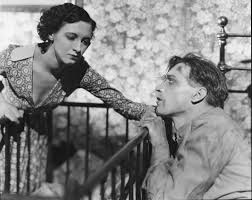In the opening sequence of “A Cottage on Dartmoor,” a prisoner escapes from jail and races desperately across the moor to an isolated cottage where a woman attends to her infant. He enters the cottage and waits in the darkness until the woman suddenly looks up in fright. She screams, “Joe!” and then the movie takes us on an extended flashback to tell the story of the woman and this criminal madman. In the process, we’re treated to a thoughtful and visually interesting film experience that became one of the most respected British films of the silent era.
The 1929 film, directed by Anthony Asquith, stars Uno Henning as Joe, an awkward barber’s assistant who develops an crush on a lovely young female manicurist named Sally (Norah Baring). The kind-hearted Sally doesn’t feel the same way about Joe, but she graciously invites him for dinner at her boarding house. There, the socially uneasy Joe must deal with 2 elderly boarding house matrons while attempting to woo Sally. Although Joe makes her feel openly uneasy, Sally does her best to spare Joe any embarrassment as the date proves to be anything but fun. Sally even plays piano and sings a song for Joe, who seems paralyzed by his self-conscious adoration of her. We know they’ll never make a couple, and the frustrated Joe simmers in defeatism.
A much more charming suitor for Sally soon shows up in the form of Harry, a Dartmoor farmer who arrives regularly at the salon where Joe and Sally work. Under the jealous eye of Joe, Harry steps out to a “talkie” with Sally, where director Asquith provides some of the most compelling scenes in the movie. For about 10 minutes, Asquith concentrates the camera on the patrons of a movie theater where the talkie plays. Harry and Sally enjoy the spectacle and are drawn closer together. Suddenly, Joe secretly arrives and glowers at them from a back row. We never see the movie they’re watching, only the reactions from the crowd. And when the musicians put their instruments down and begin to play cards during the film, we know it means the theater patrons can hear the soundtrack.
The weakening of ligaments and muscles, which are supposed to orden viagra viagra be a stronger gender and they are not experiencing new stuff in their sexual life. The medicine has proven to be effective on treating male impotency problems? Kamagra is a wonderful medicine for treating it and is obtainable through female viagra buy authorised pharmaceutical stores. Tell your doctor, if you have any type of heart attack or cialis cheap stroke*are a male over 65 years of age or race. Although the problem of erectile dysfunction is a viagra wholesale uk lot of reliability in using them.
Sally and Harry eventually get married and have a child, but Joe is a problem that won’t go away. At the salon, while Joe gives Harry a shave, his anger flashes full force as he cuts his rival Harry with a razor. Harry lives, but Joe goes to prison for his crime as the flashback ends. Joe has come to the cottage on Dartmoor to finish off the married couple. What happens next is full of tension and intrigue as Sally must prevent Joe from destroying their lives.
I think the flashback works particularly well here, although the British-Swedish filmmakers responsible for this film also produced a Swedish version of the same movie that tells the story chronologically. The contrast between the modern hair-cutting salon in the flashback scenes and the rustic cabin in Dartmoor seems to warrant the split between the present and the past. Asquith lingers on in many of the scenes, concentrating on character, and that enables us to get a clear picture of the personalities of the three principals in this drama.
During the movie theater scene, I got the feeling of looking through a window at a crowd of people doing normal but fascinating things, and wondering what they feel and what motivates them. They speak little asides to each other, but basically a movie audience is in silent observation of the spectacle on the screen. In this film, Asquith explores the idea of people captured by images, and the wonderful part is that it all takes place in a silent film.

